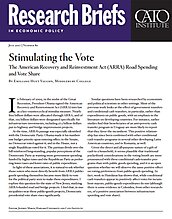In February of 2009, in the midst of the Great Recession, President Obama signed the American Recovery and Reinvestment Act (ARRA) into law as a key countercyclical stimulus measure. Nearly $800 billion was allocated through ARRA, and of that, $105 billion was designated specifically for infrastructure investments, including $27.5 billion put to highway and bridge improvement projects.
At the time, ARRA’s passage was especially identified with the Democratic Party: Obama made it his numberone budget priority upon entering office; in the Senate, no Democrat voted against it; and in the House, not a single Republican voted for it. The partisan divide over the bill reinforced long-standing, popular perceptions of the Democratic Party as wanting more government spending funded by higher taxes and the Republican Party as preferring lower taxes and lower rates of public expenditure.
In light of these associations, it is natural to ask whether those voters who most directly benefit from ARRA publicgoods spending themselves became more likely to vote for the political party seen to make these expenditures. I explore this question for the state of New Jersey, studying ARRA-funded road and bridge projects. I find that, in municipalities near these public-goods projects, Democratic presidential vote share rises significantly.
Similar questions have been researched by economists and political scientists in other settings. Most of the previous work looks at the effect of government transfers and conditional cash transfers, in particular, rather than expenditures on public goods, with an emphasis in the literature on developing countries. For instance, earlier studies find that beneficiaries of an anti-poverty cash transfer program in Uruguay are more likely to report that they favor the incumbent. This positive relationship has since been confirmed with other conditional cash transfer programs in several other developing Latin American countries, and in Romania, as well.
Given the direct and all-purpose nature of a gift of cash to a household, it seems plausible that traditional pocketbook considerations in the voting booth are more pronounced with these conditional cash-transfer programs than with public-goods spending, and it is an open question whether we will observe the same positive effect on voting preferences from public-goods spending. In fact, work in Honduras has shown that, while conditional cash transfers appear to positively affect votes for incumbent mayors, public-goods expenditures do not (although there is some evidence in Colombia, from other researchers, of a positive association between infrastructure spending and vote share).
Focusing on the United States and using a simple quasi-experimental design, my research presents novel findings on the effect of public-goods spending on vote share. I estimate that being close to (within approximately three miles (five kilometers)) the origin of an ARRA road project leads to about a 1.7 percentage point increase in the presidential vote share received by the Democratic Party. The assumption required to attribute the vote change to the public-goods spending is a “common trends” assumption that areas both near and far from eventual ARRA road projects would have otherwise (absent ARRA) trended similarly in voting outcomes. This assumption is lent support by the comovement in the pre-ARRA time series of Democratic presidential vote shares for areas that ended up getting ARRA road projects and for those that did not. I also show that the effect on presidential elections is consistent with voters crossing party lines, or switching parties, while there is no effect on total turnout.
The finding is broadly consistent with two alternative mechanisms. The first draws from the salience literature in public finance and a special feature of the ARRA-funded road projects: by federal regulation, all ARRA projects were expected to include signage explaining that the road improvements were funded by government tax dollars. This regular reminder of the source of largely valued public goods, in effect, made the benefits of taxation more salient than otherwise. As voters in the surrounding areas were presumably exposed to the public goods and accompanying signs more frequently, this may have caused them to update their political preferences to a greater degree in support of a more liberal position on the tax-and-spend continuum, shifting votes to the Democratic Party.
Another possible mechanism that could explain the results, which I term a local political multiplier effect, has less to do with underlying political preferences regarding the appropriate level of taxation and spending. If public-goods spending does stimulate the local economy (as intended) in the area of the road project, then voters in these areas may be more likely to support the incumbent (in this case a Democrat) because of the relatively good economic conditions rather than because of any updated ideological position on the proper role of government in the economy. Indeed, existing scholarship has found evidence of significant fiscal multiplier effects from ARRA spending, and others demonstrate that politicians receive more votes when an individual’s economic conditions are good (for reasons completely unrelated to the policy choices of politicians, such as being a lottery winner). I test the implications of this political multiplier channel but find little support for it, suggesting that the salience channel may be a better explanation of the results, with associated implications for future policy design.
NOTE
This research brief is based on Emiliano Huet-Vaughn, “Stimulating the Vote: ARRA Road Spending and Vote Share,” SSRN, December 22, 2016, https://papers.ssrn.com/sol3/papers. cfm?abstract_id=2891046.
